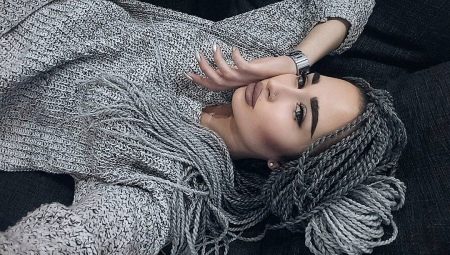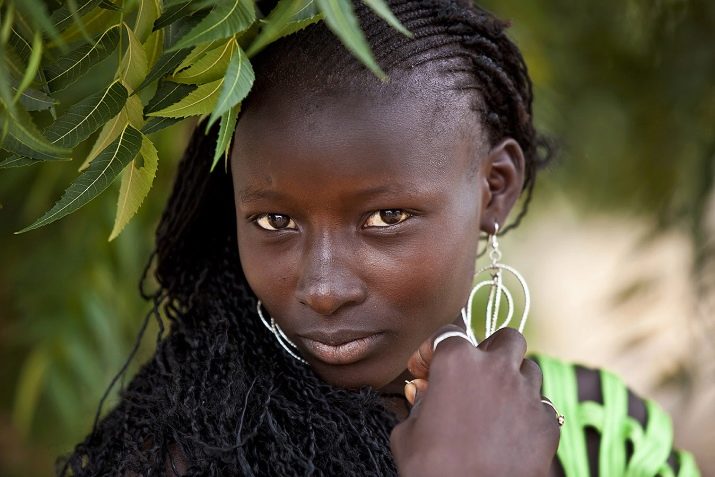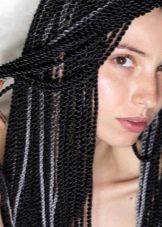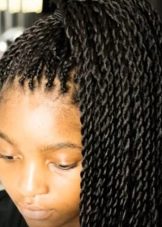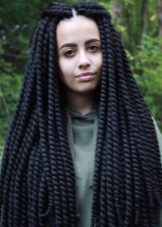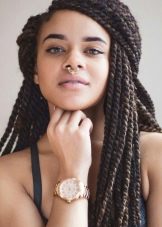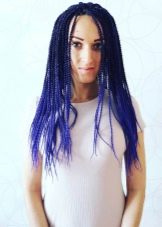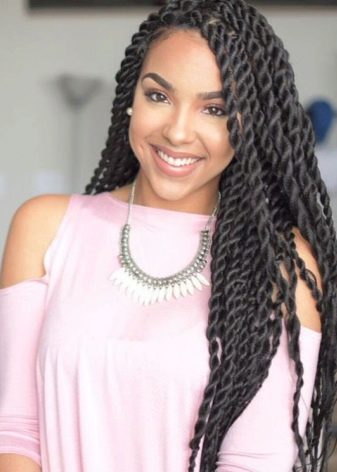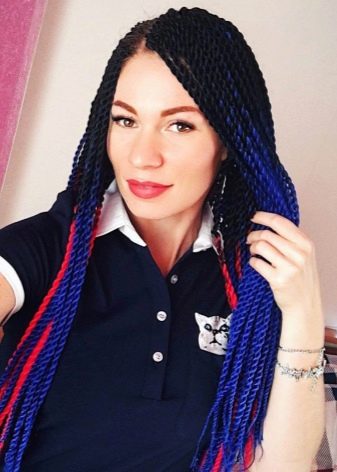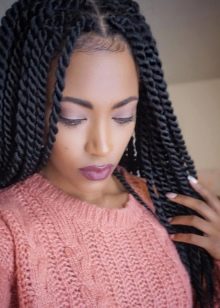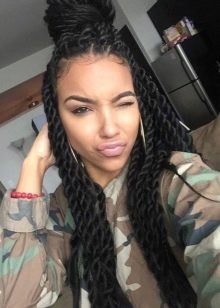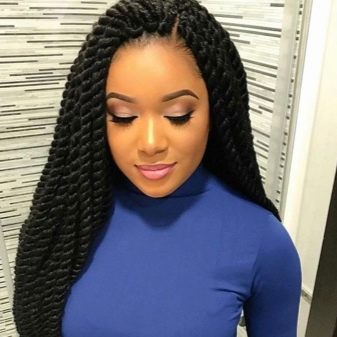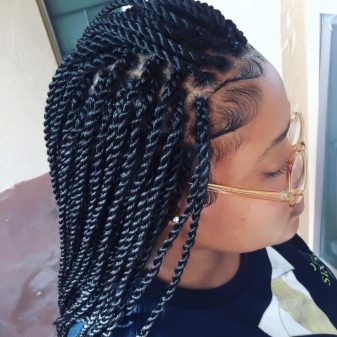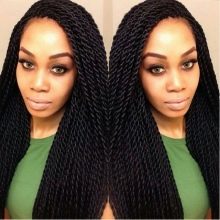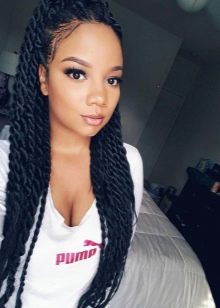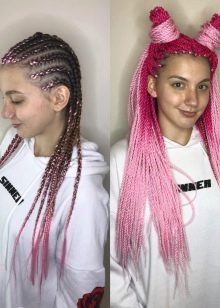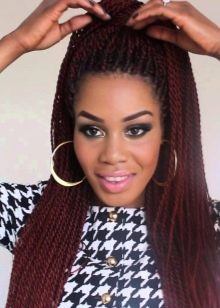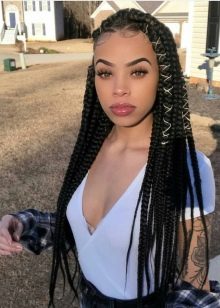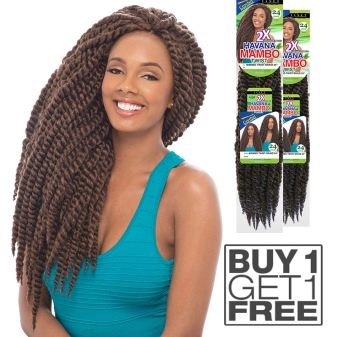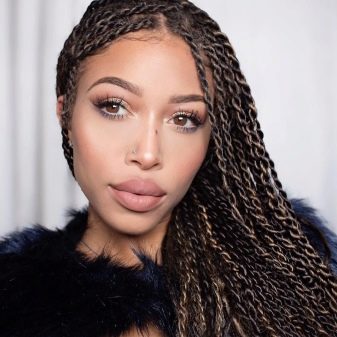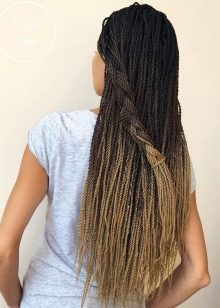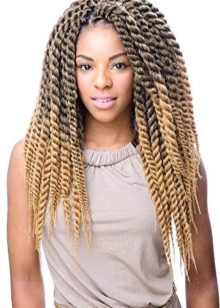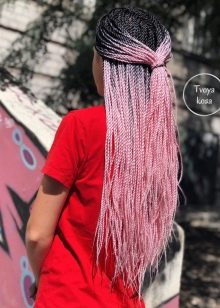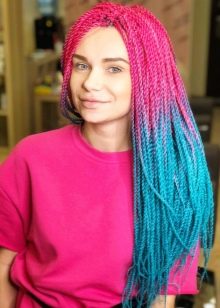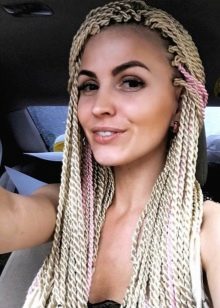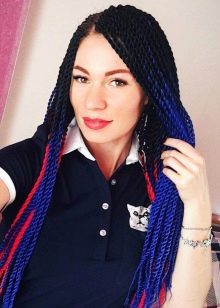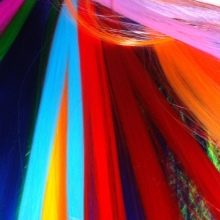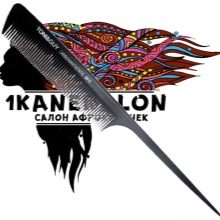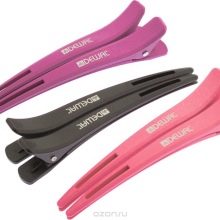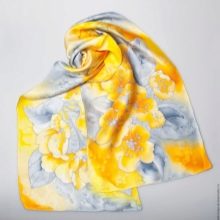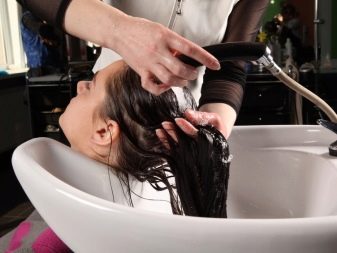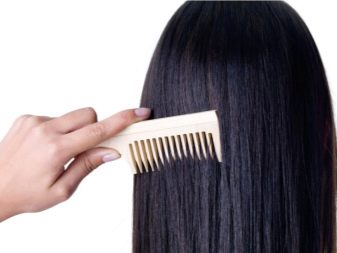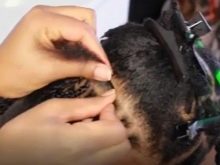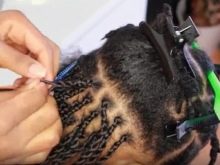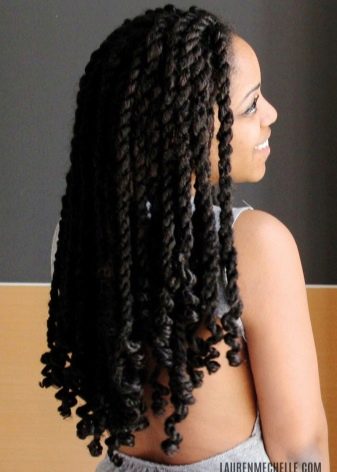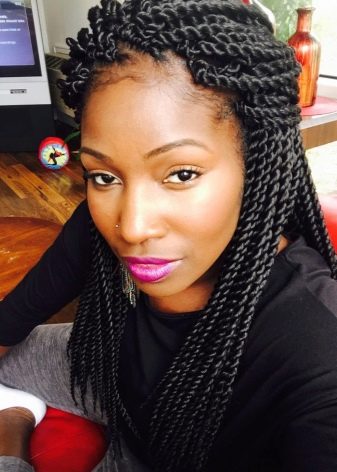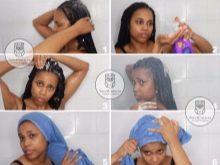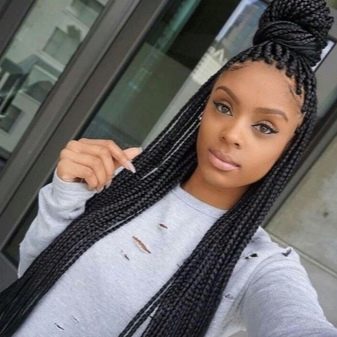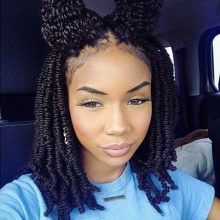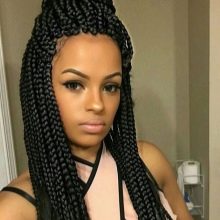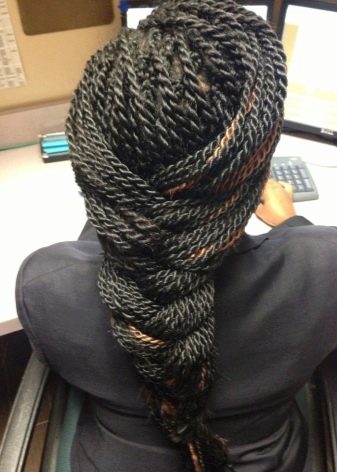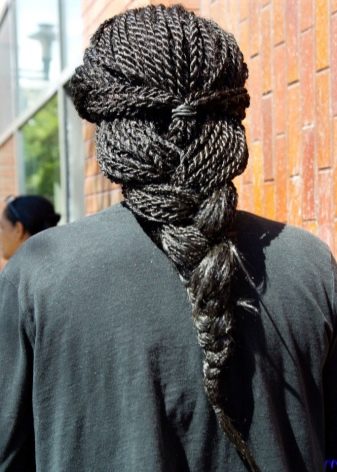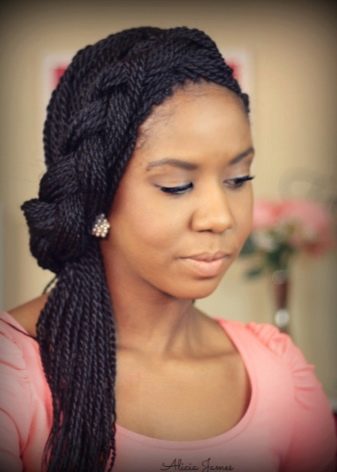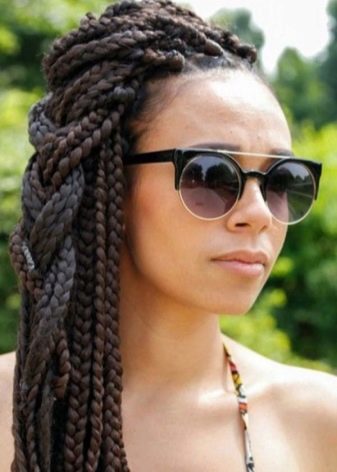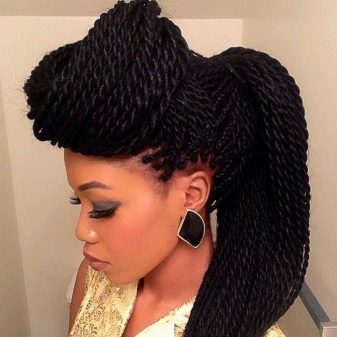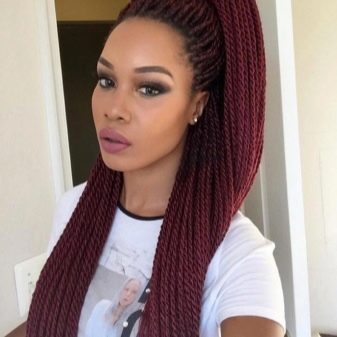Many women want to make their appearance unusual, without resorting to any complex and expensive procedures. An excellent option for non-standard and practical haircuts are Senegalese braids, which are especially popular among ladies who are not afraid to attract the attention of others. Such braids have a certain ethnicity, but at the same time can be amazingly beaten with modern accessories.
Before weaving on the hair of such bundles it is recommended to familiarize yourself with the peculiarities of this process, the rules of care and other nuances that affect the result. All the necessary information will be presented in detail in this article.
Features
Senegalese braids, as well as simple African ones, originate in the territory of the African continent in the country of Senegal. The main difference from the classical version of braids is the number of strands of which they consist - only 2 pieces. Such weaving immediately takes on a more unusual look. For such braids can be used as natural hair, and artificial fibers, such as, for example, Kanekalon. It is calculated based on the desired length of the strands, as well as the color that you wish to choose for this hairstyle.
Advantages and disadvantages
Like any afrokosy, Senegalese weaving has its advantages and disadvantages that must be considered before creating such a hairstyle. The main advantages of such bundles include a number of characteristics.
- Weave such braids can, almost regardless of the original length of natural hair, so this hairstyle can embody a greater number of women. Sufficient length of natural strands - 7 centimeters.
- These braids are not as heavy as classical African ones; they put less pressure on the root zone. Therefore, this hairstyle is quite acceptable for weak and thin curls.
- Thanks to the possibility of weaving artificial strands of various shades into the bulk of the hair, you can add any color to the hair and also use the ombre technology and the material that will change the tone depending on the lighting. Some strands can even glow in the dark.
- Plaits can be made independently by having some experience in braid weaving, as well as free time.
- With a similar hairstyle there is no need to wash your hair every day. Therefore, it is often chosen for travel.
- Thanks to the interweaving of artificial hair, you can experiment by creating bundles of various thicknesses.
This hairstyle has its drawbacks.
- The term of operation, as a rule, does not exceed two months in comparison with other African methods of weaving.
- Hairstyle can not be supplemented with any accessories, beads and other decorative elements, for example, as in dreadlocks. They will increase the load and reduce the life of this hairstyle.
- After braiding, you need to regularly take care of such harnesses, using many different means to preserve their presentable appearance.
Who are you going?
Senegalese braids are not suitable for every lady. This hairstyle looks best on those women who have an oval face shape.Such weaving assumes that the face will be completely open, it emphasizes the forehead, as well as the line of the cheekbones and chin.
If the forehead is rather large and the chin is heavy, then it is better to refrain from weaving such braids.
If you like to wear bangs, you will most likely have to weave them in braids. The original concept of this hairstyle does not imply that the forehead was covered with hair. But modern ladies sometimes leave a bang, if it is thick and straight.
But also important is the overall style, which adheres to the girl. Clothing must be in harmony with the hairstyle. The most relevant in combination with similar harnesses look youth styles, such as casual. And also such braids look good in the image of girls who love ethnic prints in clothes. But the glamorous or strict lady who prefers classic style, Senegalese braids will not work.
Popular colors
In the choice of color strands for Senegalese harnesses a number of trends can be traced, each of which brings a certain highlight to the image of girls.
- Solid natural colors are a classic version. It is preferred by those girls who only need to emphasize the unusual texture of hair. As well as natural colors, it will be appropriate to look at lovers of ethnic style and an abundant number of accessories. They will not overload the image.
- Ombre technique is still popular with young people. Among the artificial products for such braids are options with different color transitions from dark to light. Special attention deserve strands, dark at the roots and gray at the ends.
- Colored artificial materials suitable for those young ladies who want to impress others. However, some girls just spice up her hair, weaving a few colored strands into natural-colored braids.
Necessary tools and materials
Before you create a similar hairstyle, you should stock up with all the materials, tools and some other compositions, necessary for the full procedure.
- Kanekolonovaya thread in the amount of four packs. It is necessary if you want to use additional material besides your own hair. Especially this thread will be needed if you want to make colored brades.
- Comb for dividing the hair into strands, as well as the usual - for combing.
- Means for disentanglement of hair will be a useful component for the preparation of natural strands for weaving.
- To fix Kanekolonovye thread in natural hair, you can use a special hook, which is used to build curls. This tool will help thread the artificial strand.
- Clips for hair will help to separate and secure the required number of strands, so that it is convenient to braid hair in small sections.
- You will also need a pot of boiling water, a scarf made of silk or satin, a special oil for hair.
Weaving techniques
At the first stage it is necessary to prepare a natural head of hair and artificial strands. The latter is enough to double and cut to the desired length, but your hair should be washed, combed and sprinkled with a means of preventing tangling of the strands. Then you should dry the hair with a hair dryer.
It is not recommended to lubricate hair with oils, because their texture will become slippery and it will be inconvenient to do hair.
Weaving starts from below. Limit the lowest layer of hair, securing the rest of the mass at the top with clips. Choose a strand of small width in the middle of the bottom layer and carefully comb it.
Weaving of Senegalese braids for both short and long hair begins in the same way - with the creation of durable weaving of three strands at the roots, which create an additional fixation for the braids.If you weave artificial threads, you need to prepare them: fold the thread of the desired length in half, weave the fold into natural hair, so that when the weave begins, the two parts of the fold are not in the next strands.
Weave 2-3 centimeters in a similar way, and then the rest of the hair should be divided into two parts and twisted into a bundle. These harnesses should then be twisted around each other in one direction. Repeat this procedure with the rest of the hair mass. Remember that it is recommended to weave pigtails of the same thickness, otherwise the overall look will look sloppy. The number of additional strands in each harness should also be the same.
In order not to spread the bundles, you can additionally “seal” their ends using boiling water. To do this, bring it to a boil in the pan at the time of weaving the braid. Dip the tip of each wire into boiling water so that it is completely immersed in it. Do the same procedure with the rest of the strands, regardless of whether artificial or natural materials are used when weaving, this technology works. But if the hair is not sectioned at the ends, then it will be necessary to fasten each bundle with a rubber band before fixing it with boiling water.
After that, it is not recommended to dry your head with a hair dryer, so wait for the self-drying of the hair. As an additional procedure, you can lubricate the ends of the resulting braids with olive oil, which will help to retain some of the moisture in the hair. Then the curls should dry out again naturally.
How to care?
Care directly affects how long your Senegalese braids will last without losing accuracy and aesthetic appearance. Therefore, you need to take care of the harnesses.
- Wash your hair only once a week. At the same time, the shampoo needs to be diluted with 1 to 2 water. From more frequent washing, the strands will look stretched much faster.
- To moisturize the scalp, at least a couple of times a week should be applied to it with coconut, oil or peppermint oil.
- Do not use air conditioners that require flushing. Instead, choose analogs in the form of a spray and spray them daily on the braids.
- To keep the braids from getting battered during sleep, they need to be protected by collecting them in a ponytail and then tying a scarf from smooth materials. Alternatively, a hair dye cap can be used.
Hairstyles with braids
If you think that loose hair is the only option for hairstyles from Senegalese braids, then you are mistaken. There are a huge number of ways to put such harnesses, thereby creating a variety of images:
- you can collect the upper part of the hair and twist it into a volume bundle, while leaving the lower part loose;
- Senegalese braids, collected in a cone, will give an additional piquancy to the image
- Even more interesting is the braid braided along the hairline, turning into a neat knot;
- You can also make a horse tail or a more extravagant version of it by placing the front part of the hair at the top.
How to braid the Senegalese braids with your own hands, see the video below.
